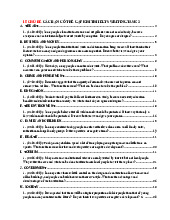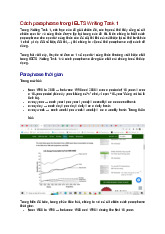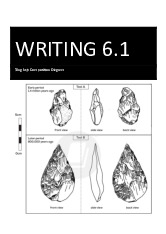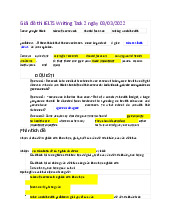






Preview text:
23.8.21 READING PASSAGE 1
You should spend about 20 minutes on , which ar Questions 1-13
e based on Reading Passage 1 below. DEPRESSION
A. It is often more difficult for outsiders and non-sufferers to understand mental rather than physical illness in others.
While it may be easy for us to sympathise with individuals living with the burden of a physical illness or disability,
there is often a stigma attached to being mentally ill, or a belief that such conditions only exist in individuals who
lack the strength of character to cope with the real world. The pressures of modern life seem to have resulted in an
increase in cases of emotional disharmony and government initiatives in many countries have, of late, focussed on
increasing the general public’s awareness and sympathy towards sufferers of mental illness and related conditions.
B. Clinical depression, or ‘major depressive disorder’, a state of extreme sadness or despair, is said to affect up to
almost 20% of the population at some point in their lives prior to the age of 40. Studies have shown that this disorder
is the leading cause of disability in North America; in the UK almost 3 million people are said to be diagnosed with
some form of depression at any one time, and experts believe that as many as a further 9 million other cases may go
undiagnosed. World Health Organisation projections indicate that clinical depression may become the second most
significant cause of disability’ on a global scale by 2020. However, such figures are not unanimously supported, as
some experts believe that the diagnostic criteria used to identify the conditi ՛
on are not precise enough, leading to
other types of depression being wrongly classified as ‘clinical’.
C. Many of us may experience periods of low morale or mood and feelings of dejection, as a natural human response
to negative events in our lives such as bereavement, redundancy or breakdown of a relationship. Some of us may
even experience periods of depression and low levels of motivation which have no tangible reason or trigger.
Clinical depression is classified as an on-going state of negativity, with no tangible cause, where sufferers enter a
spiral of persistent negative thinking, often experiencing irritability, perpetual tiredness and listlessness. Sufferers of
clinical depression are said to be at higher risk of resorting to drug abuse or even suicide attempts than the rest of the population.
D. Clinical depression is generally diagnosed when an individual is observed to exhibit an excessively depressed
mood and/or ‘anhedonia’ – an inability to experience pleasure from positive experiences such as enjoying a meal or
pleasurable social interaction – for a period of two weeks or more, in conjunction with five or more additional
recognised symptoms. These additional symptoms may include overwhelming feelings of sadness; inability to sleep,
or conversely, excessive sleeping; feelings of guilt, nervousness, abandonment or fear; inability to concentrate;
interference with memory capabilities; fixation with death or extreme change in eating habits and associated weight gain or loss.
E. Clinical depression was originally solely attributed to chemical imbalance in the brain, and while anti-depressant
drugs which work to optimise levels of ‘feel good’ chemicals – serotonin and norepinephrine – are still commonly
prescribed today, experts now believe that onset of depression may be caused by a number, and often combination
of, physiological and socio-psychological factors. Treatment approaches vary quite dramatically from place to place
and are often tailored to an individual’s particular situation; however, some variation of a combination of medication
and psychotherapy is most commonly used. The more controversial electroconvulsive therapy (ECT) may also be
used where initial approaches fail. In extreme cases, where an individual exhibits behaviour which Indicates that
they may cause physical harm to themselves, psychiatric hospitalisation may be necessary as a form of intensive therapy.
F. Some recent studies, such as those published by the Archives of General Psychiatry, hold that around a quarter of
diagnosed clinical depression cases should actually be considered as significant but none-the-less ordinary sadness 23.8.21
and maladjustment to coping with trials in life, indicating that in such cases, psychotherapy rather than treatment
through medication is required. Recovery as a result of psychotherapy tends, in most cases, to be a slower process
than improvements related to medication; however, improvements as a result of psychological treatment, once
achieved, have been observed in some individuals to be more long term and sustainable than those attained through
prescription drugs. Various counselling approaches exist, though all focus on enhancing the subject’s ability to
function on a personal and interpersonal level. Sessions involve encouragement of an individual to view themselves
and their relationships in a more positive manner, with the intention of helping patients to replace negative thoughts with a more positive outlook.
G. It is apparent that susceptibility to depression can run in families. However, it remains unclear as to whether this
is truly an inherited genetic trait or whether biological and environmental factors common to family members may
be at the root of the problem. In some cases, sufferers of depression may need to unlearn certain behaviours and
attitudes they have established in life and develop new coping strategies designed to help them deal with problems
they may encounter, undoing patterns of destructive behaviour they may have observed in their role models and acquired for themselves. Questions 1-5
Reading Passage 1 has seven sections A-G.
Which paragraph contains the following information?
Write the correct letters A-G in boxes 1-5 on your answer sheet. 1
Details of treatment alternatives for worst case scenario depression. 2
Information regarding cases where drug treatment is inappropriate. 3
Details of how those diagnosed with depression may be more vulnerable than other members of society, 4
Information about society’s attitudes to depression and similar illnesses. 5
Information regarding why estimates of incidence of future growth in cases may be overly exaggerated. Questions 6-8
Choose THREE letters A-G.
Write your answers in boxes 6-8 on your answer sheet.
NB Your answers may be given in any order
Which THREE of the following statements are true of depression? A
Governments have generally failed to take action to educate the general public about the condition. B
The highest reported number of cases are in the USA. C
In Britain, it is likely that there are more individuals who live with the condition without the help of a
doctor than those being officially treated. 23.8.21 D
Clinical depression may be triggered by divorce. E
Lethargy may be one of the symptoms of depression. F
Prescribed pharmaceuticals have radically changed over recent years. G
Approaches to treating depression are not universal. Questions 9-13
Complete the summary of paragraphs F and G with the list of words A-L below.
Write the correct letter A-L in boxes 9-13 on your answer sheet.
Whilst recovery through counselling rather than medicine may be more 9 , results once achieved may have more 10 with some patients.
Counselling sessions are geared towards improving the subject’s relationship with others and their own 11
, encouraging sufferers of depression to take on a more 12 outlook.
The extent to which genetic disposition and sociological factors impact on state of mind is 13 . Many
people undergoing counselling therapy do so with the purpose of unlearning negative behaviour and reactions. A gratifying B longevity C ambition D optimistic E pessimistic F difficulty G inconclusive H self-image I gradual J unequivocal K immediate L categorical READING PASSAGE 2 23.8.21
You should spend about 20 .minutes on Questions 14-27, which are based on Reading Passage 2 below. THE FACE OF MODERN MAN?
A. In response to the emergence of the ‘metro-sexual’ male, In other words, an urban, sophisticated man who is
fashionable, well-groomed and unashamedly committed to ensuring his appearance is the best it can be, a whole
new industry has developed. According to research conducted on behalf of a leading health and beauty retailer
in the UK, the market for male cosmetics and related products has grown by 800% since the year 2000 and is
expected to continue to increase significantly. The male grooming products market has become the fastest
growing sector within the beauty and cosmetics industry, currently equivalent to around 1.5 billion pounds per annum.
B. Over the last decade, a large number of brands and companies catering for enhancement of the male image
have been successfully established, such operations ranging from male-only spas, boutiques, personal hygiene
products, hair and skin care ranges, and male magazines with a strong leaning towards men’s fashion. Jamie
Cawley, proprietor of a successful chain of London-based male grooming boutiques, holds that his company’s
success in this highly competitive market can be attributed to the ‘exclusivity’ tactics they have employed, in
that their products and services are clearly defined as male- orientated and distinctly separate to feminine
products offered by other organisations. However, market analyst, Kim Sawyer, believes that future growth in
the market can also be achieved through sale of unisex products marketed to both genders, this strategy
becoming increasingly easy to implement as men’s interest in appearance and grooming has become more of a social norm.
C. Traditionalists such as journalist Jim Howrard contend that the turn-around in male attitudes which has led to the success of the industry been inconceivable w’ould have
a decade ago, given the conventional male role,
psyche and obligation to exude ; however masculinity
, behavioural scientist Professor Ruth Chesterton argues
that the metro-sexual man of today is in fact a modern incarnation of the ‘dandy’ of the late eighteenth and early
nineteenth century. British dandies of that period, who were often of middle class backgrounds but imitated
aristocratic lifestyles, were devoted to cultivation of their physical appearance, development of a refined
demeanour and hedonistic pursuits. In France, she adds, dandyism, in contrast, was also strongly linked to
political ideology and embraced by youths wishing to clearly define themselves from members of the working
class revolutionary social groups of the period.
D. Over recent decades, according to sociologist Ben Cameron, gender roles for both sexes have become less
defined. According to research, he says, achievement of status and success have become less important in
younger generations of men, as has the need to repress emotions. Cameron defines the traditional masculine role
within western societies – hegemonic masculinity – as an expectation that males demonstrate physical strength
and fitness, be decisive, self-assured, rational, successful and in control. Meeting this list of criteria and
avoiding situations of demonstrating weakness, being overly emotional or in any way ’inferior’, he says, has
placed a great deal of pressure on many members of the male population. So restrictive can society’s pressure to
behave in a ‘masculine’ fashion on males be, Professor Chesterton states that in many situations men may
respond in a way they deem acceptable to society, given their perceived gender role, rather than giving what
they may actually consider to be the best and most objective response.
E. Jim Howard says that learning and acquiring gender identity makes up a huge component of a child’s
socialisation and that a child who exhibits non-standard behavioural characteristics often encounters social and
self image difficulties due to the adverse reactions of their peers. According to Kim Sawyer, media images and 23.8.21
messages also add to pressures associated with the male image, stating that even in these modern and changing
times, hegemonic masculinity is often idolised and portrayed as the definitive male persona.
F. Whilst male stereotypes and ideals vary from culture to culture, according to Professor Chesterton, a
universal trait in stereotypical male behaviour is an increased likelihood to take risks than is generally found in
female behaviour patterns. For this reason, she attributes such behaviour to the influence of genetic
predisposition as opposed to socially learned behaviour. Men, she says, are three times more likely to die due to
accident than females, a strong indication he says of their greater willingness to involve themselves in
precarious situations. Ben Cameron also says that an attitude of invincibility is more dominant in males and is a
predominant factor in the trend for fewer medical checkups in males and late diagnosis of chronic and terminal
illness than in their more cautious and vigilant female counterparts.
G. Jamie Cawley, however, remains optimistic that the metro-sexual culture will continue and that what society
accepts as the face of masculinity will continue to change. He attributes this to a male revolt against the strict
confines of gender roles, adding that such changes of attitudes have led and will continue to lead to
establishment of greater equality between the sexes. Questions 14-18
Reading Passage 2 has seven paragraphs A-G.
Choose the correct heading for paragraphs B-D and F-G from the list of headings below.
Write the correct number i to viii in boxes 14-18 on your answer sheet. List of Headings i Basis and predictions ii Revolution or recurrence? iii Servicing a growing demand iv
The surfacing of a new phenomenon v
A long-held mindset and its downsides vi Influence on minors vii Hereditary predilection for viii Effects of external pressures
Example: Paragraph E; Answer: viii 14 Paragraph B 15 Paragraph C 16 Paragraph D 17 Paragraph F 23.8.21 18 Paragraph G Questions 19-22
In boxes 19-22 on your answer sheet, write TRUE
if the statement agrees with the information FALSE
if the statement contradicts the information NOT GIVEN
If there is no information on this 19
Sales in the female health and beauty market have slightly declined over recent years. 20
The rise of ‘dandyism’ in England and France is attributed to similar factors. 21
Emotional reaction is contradictory to hegemonic masculine behaviour. 22
There is a correlation between men’s belief that they are indestructible and their decreased
likelihood to seek medical advice. Questions 23-27
Look at the following list of statements (Questions 23-27) based on changes in male image and behavior.
Match each statement with the correct person . A-E
Write the correct letters in boxes A-E
23-27 on your answer sheet. 23
Male behaviour patterns have changed in a way that would have been considered implausible in the past. 24
Traditional benchmarks of masculinity are often exacerbated by the press. 25
Metro-sexual culture has developed as a response to modern men’s dissatisfaction with traditional images. 26
The need to conform to society’s expectations of male behaviour may impede men’s decision- making and judgement. 27
There is potential in a market which makes no differentiation between products for males and females. List of Contributors A Jamie Cawley B Kim Sawyer C Jim Howard 23.8.21 D Professor Ruth Chesterton E Ben Cameron




